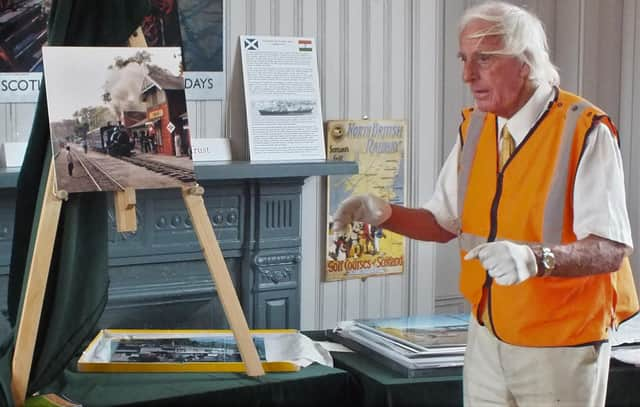Obituary: John Clemmens, engineer and railway photographer


John Clemmens was a youngster growing up in north London during the Second World War when his interest in railways was first sparked by train trips to the Kent coast.
Escaping a world coloured by the Blitz and tales of Dunkirk, he used to visit an aunt in Margate where preparations were being made for D-Day. For a schoolboy, the excitement of the times – plus the drama of being on steam trains stuck in tunnels sheltering from air raids – was unforgettable.
Advertisement
Hide AdAdvertisement
Hide AdAnd he was just 11 or 12 when, using a Kodak Box Brownie, he began photographing railways, later recalling how the London terminal stations and their locomotive depots “were an absolute paradise for young spotters”.
It was around the same time that his mother Doris died of breast cancer and his much older sister, June, helped their father, also John, to raise the boy, a self-confessed tearaway.
He was in his late teens when wanderlust first took him to India, spurred by his twin passions of photography and steam trains. Accompanied by one of his Hasselblad cameras, he would become a regular visitor and a world-renowned railway photographer with a portfolio of the country’s famous Toy Train railway spanning half a century.
He fitted this in around a working life which began in 1951 with an apprenticeship with the de Havilland Engine Company, where he became involved with the latest gas turbine engines: the Goblin, which powered Vampire jets, and the Ghost, which powered the Venom and early Comets.
The de Havilland apprenticeship proved an excellent foundation for a long career in engineering but he went on to take up other opportunities with the Exxon Corporation and was posted to Libya and other parts of the Middle East.
He also worked in the early years of the North Sea oil industry and finished his career at the Exxon petrochemical plant at Mossmorran.
Having lived for a time in Wokingham, Berkshire – where he bought a house adjacent to a rail line so he could observe passing steam trains – he later settled in North Queensferry and every year, from 1972, travelled to the Darjeeling Himalayan Railway (DHR), also known as the Toy Railway, a line he had first visited a decade earlier as part of a three-month tour of India.
Although steam trains were a lifelong passion it was the narrow-gauge DHR line that really captured his imagination and he always spent Christmas and New Year at Darjeeling’s Windamere Hotel, one of India’s oldest colonial hotels, where his quirky personality and sense of humour was much appreciated by other regulars.
Advertisement
Hide AdAdvertisement
Hide AdOn each visit he engaged the same taxi driver, who knew to stop all traffic on the adjacent road to give his camera an unobstructed view of the approaching train.
Every room in the hotel is said to feature at least one of his photographs and his presence there was such that, after news of his death broke, prayers were chanted for him in the property’s DHR Club.
John joined the Darjeeling Himalayan Railway Society in 2000, soon after its formation, his photographs featuring frequently in the Society’s journal, the Darjeeling Mail. And in 2013 he self-published a book chronicling his 50 years of photographing the DHR.
Meanwhile, in retirement in Scotland, he was heavily involved in the North Queensferry Heritage Trust, as a trustee and founding member. There he shared his enthusiasm and engineering skills in the restoration of model yachts, fine woodwork and metal work.
His expertise was particularly appreciated during the restoration of the world’s smallest working light tower, built by Robert Stevenson on North Queensferry’s Town Pier.
Brought back into full working order, it reopened to the public in 2010 when the Princess Royal relit the lamp, 120 years after it was last used.
In 2015 the Forth Rail Bridge was declared a Unesco World Heritage site, a status shared with the DHR, and that September North Queensferry station was transformed into Darjeeling for the weekend to reflect the success. With the permission of Transport Scotland, the joint event by the DHR Society and the North Queensferry Heritage Trust saw the station rebranded with Indian flags and signage in Hindi.
Everything was in order until, the night before the event was to open, a ScotRail driver, barely able to believe his eyes, reported that he feared the station may have fallen into the hands of Isis. A team of managers was dispatched to investigate and the event went ahead – no doubt much to the amusement of the effervescent Clemmens, who attended both days giving photography tutorials and discussing his love of the DHR.
Advertisement
Hide AdAdvertisement
Hide AdIn a life of boundless energy and enthusiasm, particularly for his beloved dogs, he was instantly recognisable with his trademark long white tresses, larger-than-life personality and vice-like handshake.
An inveterate whistler and people-watcher who could not resist teasing or playing tricks on people – even those he didn’t know – he collected friends from all over the world and all walks of life who were inevitably drawn in by his gusto and humour.
As he said himself: “Having a childish and light-hearted spirit without compromise has really allowed me to enjoy life to the full.”
Predeceased by his wife Frances in 2010, he is survived by stepdaughters Ruth and Jane, his niece Christine, nephew Peter and extended family.